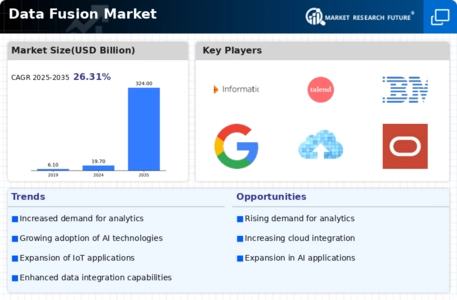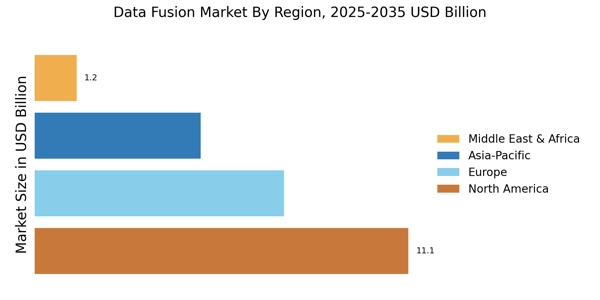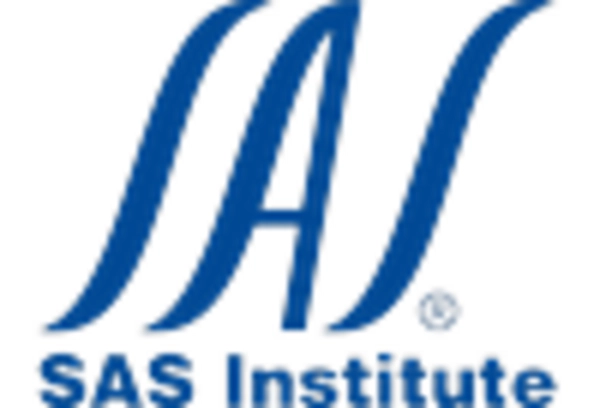North America : Data Fusion Market Leader
North America is the largest market for data fusion, holding approximately 45% of the global share. The region's growth is driven by rapid technological advancements, increasing data generation, and a strong emphasis on data-driven decision-making. Regulatory support, particularly from government initiatives promoting data integration and analytics, further fuels demand. The U.S. leads this market, followed closely by Canada, which contributes around 15% to the overall market share.
The competitive landscape in North America is robust, featuring key players such as IBM, Oracle, and Microsoft. These companies are at the forefront of innovation, offering advanced data fusion solutions that cater to various industries, including healthcare, finance, and retail. The presence of numerous startups and established firms enhances the region's market dynamics, fostering a culture of continuous improvement and technological evolution.
Europe : Emerging Data Fusion Market Hub
Europe is witnessing significant growth in the data fusion market, accounting for approximately 30% of the global share. The region's expansion is propelled by increasing investments in digital transformation and the adoption of advanced analytics. Regulatory frameworks, such as the General Data Protection Regulation (GDPR), are also shaping the market by emphasizing data privacy and security, which in turn drives demand for sophisticated data fusion solutions. Germany and the UK are the largest markets, together holding about 20% of the total market share.
Leading countries in Europe, including Germany, the UK, and France, are home to several key players like SAP and TIBCO Software. The competitive landscape is characterized by a mix of established firms and innovative startups, all striving to enhance their offerings. The focus on sustainability and compliance with stringent regulations is pushing companies to adopt data fusion technologies that not only improve efficiency but also ensure data integrity and security.
Asia-Pacific : Rapidly Growing Market
Asia-Pacific is emerging as a significant player in the data fusion market, holding around 20% of the global share. The region's growth is driven by the increasing adoption of cloud computing, big data analytics, and the Internet of Things (IoT). Countries like China and India are leading this growth, supported by government initiatives aimed at enhancing digital infrastructure and promoting smart city projects. The demand for data fusion solutions is expected to rise as businesses seek to leverage data for competitive advantage.
China is the largest market in the region, followed by India, which is rapidly catching up. The competitive landscape features both global giants and local players, with companies like Palantir Technologies and SAS Institute making significant inroads. The focus on innovation and the growing need for data-driven insights are propelling the market forward, making Asia-Pacific a key region for future growth in data fusion technologies.
Middle East and Africa : Emerging Data Solutions Market
The Middle East and Africa (MEA) region is gradually emerging in the data fusion market, currently holding about 5% of the global share. The growth is primarily driven by increasing digital transformation initiatives across various sectors, including government, healthcare, and finance. Countries like the UAE and South Africa are leading this trend, supported by investments in technology and infrastructure. The demand for data fusion solutions is expected to grow as organizations seek to harness data for improved decision-making and operational efficiency.
In the MEA region, the competitive landscape is evolving, with both international and local players vying for market share. Key players include Informatica and Teradata, which are focusing on providing tailored solutions to meet the unique needs of the region. The emphasis on data security and compliance with local regulations is also shaping the market, driving organizations to adopt advanced data fusion technologies that align with their strategic goals.


















Leave a Comment